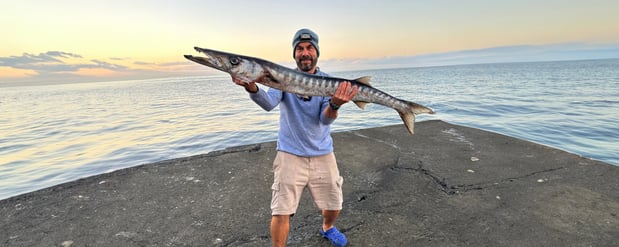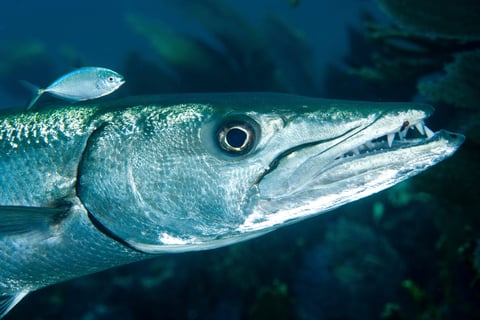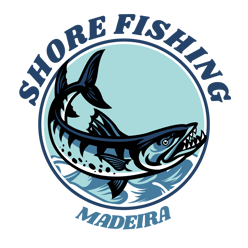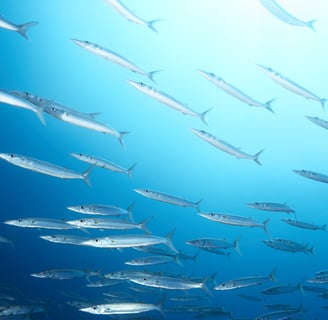Hunting Shadows: Barracuda Fishing in Madeira
A powerful coastal predator, abundant and thrilling to catch from shore year-round.
FISHING TECHNIQUES
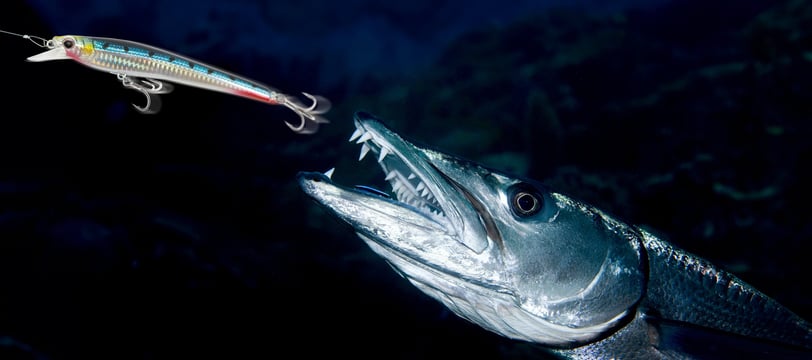

Barracuda Overview
The barracuda found in Madeira is the Great Barracuda (Sphyraena barracuda), a long, torpedo-shaped predator with a fearsome set of teeth and an explosive strike. It belongs to the Sphyraenidae family and is one of the top coastal predators in the waters surrounding the island. While some individuals are solitary, barracudas are often seen swimming in long, dispersed schools, especially during the warmer seasons.
Habitat and Behaviour
Barracudas are abundant throughout Madeira and thrive in rocky coastal areas, reefs, harbours, and drop-offs. They are highly visual predators, often ambushing prey like sardines, mackerel, or small reef fish. It’s common to encounter them during early morning or late afternoon when they’re most active.
As a fun fact, snorkellers and divers frequently report sightings of large groups of barracudas, gliding silently through the water in perfect formation. These schools often contain individuals of mixed sizes, from young juveniles to full-grown adults.
Fishing Techniques
Barracuda are aggressive and opportunistic, making them ideal targets for shore anglers using spinning gear. Whether you’re using light, medium, or heavy setups, barracuda will readily attack artificial lures of all kinds. This includes:
Hardbaits
Metal jigs
Soft plastics
Minnow-style lures
Topwater lures like poppers
They are not particularly selective and often respond best to fast, erratic retrieves. The key is to provoke their instinct to chase and strike.
Effective Lure Techniques
They are highly responsive to artificial lures, making spinning a particularly exciting and effective method from shore. Popper fishing is especially productive during surface activity, when barracuda are feeding aggressively—loud splashes and surface commotion often provoke explosive strikes. When the fish are deeper or less active near the surface, jigs (both metal and soft plastic) become ideal, allowing anglers to reach greater depths and work the water column with fast, erratic retrieves. Hard lures such as stickbaits and diving minnows also produce excellent results, particularly when they imitate the movement and size of local baitfish like sardines. While natural baitfish colours (silver, blue, white) are consistently effective, bright colours such as yellow, orange, and red can trigger strikes, especially in stained water or on overcast days. Success depends on adapting your approach to water conditions, light levels, and fish behaviour—faster retrieves tend to work better in clear water, while a slower, more subtle action can be more effective in murky conditions.
Reproduction and Spawning Behaviour
Barracudas in Madeira follow a seasonal spawning cycle, typically reproducing in the warmer months, between late spring and early autumn, when sea temperatures rise. Spawning usually takes place offshore, in deeper waters, where females release large numbers of eggs into the current, which are then fertilised externally by males.
Juvenile barracudas begin appearing closer to the coast weeks after spawning, often forming tight schools in sheltered bays, estuaries, or shallow reefs. These young fish gradually migrate into deeper areas as they grow. While exact spawning grounds around Madeira remain largely unstudied, the abundance of juvenile and mid-sized barracudas near shore suggests the surrounding waters serve as both nurseries and feeding grounds.
Understanding this cycle helps anglers fish responsibly—avoiding peak spawning periods or releasing larger breeding females can help maintain a healthy population.
Culinary Appeal
Unlike some tropical regions, Madeira’s waters are free from ciguatera toxin, making local barracuda safe to eat and highly appreciated. This predatory fish offers firm, white flesh with a delicate yet flavourful profile, making it a favourite among local fishermen and chefs alike.
In Madeira, barracuda is often fried whole or in fillets, and it's commonly used in traditional dishes like caldeirada, a hearty island-style fish stew rich in flavour. Thanks to its texture, barracuda is also excellent in ceviche, holding its shape well and absorbing citrus and spice beautifully.
Whether grilled, marinated, or stewed, barracuda remains a versatile and delicious choice in Madeiran coastal cuisine.
Barracuda Regulations
As of the current regulations, there are no specific restrictions or minimum size limits for catching barracuda (Sphyraena barracuda) in Madeira. However, anglers are encouraged to practice responsible fishing by adhering to general catch limits and considering the release of larger specimens to support population sustainability.
It's important to note that regulations can change, so it's advisable to consult the latest guidelines from the Direção-Geral de Recursos Naturais, Segurança e Serviços Marítimos (DGRM) or local authorities before engaging in fishing activities.
Quick Facts
Scientific Name: Sphyraena barracuda
Family: Sphyraenidae
Typical Size: 1–5 kg (can exceed this)
Habitat: Rocky shores, drop-offs, reefs
Best Gear: Spinning (light to heavy)
Common Lures: Jigs, hardbaits, topwater, minnows
Behaviour: Schooling predator, highly visual hunter
Regulations: No current size or catch limits

